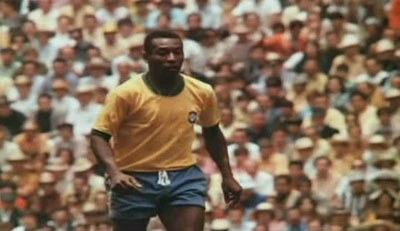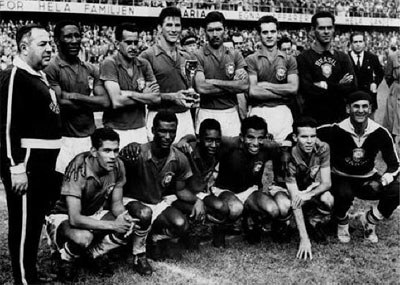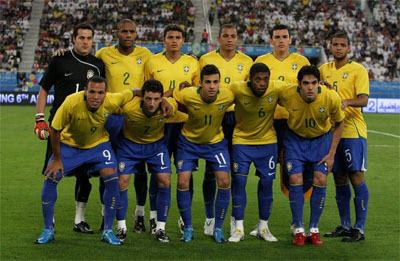Brazil
In the history of football, not a single nation has been as successful at it as Brazil. They have won five World Cup titles (most ever), and they remain the only team to have participated at every edition of the tournament. Over the years, Brazil produced some of the greatest players in the world, and many pundits consider their 1970 team to be the best squad to play the game. Their trophy room also contains eight Copa América titles and four Confederations Cups.
Main trophies
World Cup: 5
Campeonato Sudamericano / Copa América: 9
Player records
Most games played: Cafu (142)
Top goalscorer: Pelé (77)
Stats

Pelé 1970 in World Cup for Brazil in Mexico.
History
Humble beginnings
The history of international football in Brazil begins in 1914, with the foundation of the Brazilian Football Confederation (CBF). That same year, the team – consisting exclusively of São Paulo and Rio de Janeiro players – took part in its first official match against Exeter City. Interestingly, the game’s final score remains a mystery. Some sources claim that Brazil won 2-0, whereas others insist that the game ended in a 3-3 draw.
Brazil won its first major trophy in 1919, defeating Uruguay in the finals of the South American Championship (later known as Copa América). This team was led by talented striker Arthur Friedenreich, who is considered by many to be the sport’s first great mixed race player. The team repeated this success in 1922 with a controversial 3-0 victory over Paraguay. Both of these championships were played on Brazil’s home turf.
The big slump
Following the 1922 triumph, Brazil went through 27 years without trophies. This period included the first three editions of the World Cup in 1930, 1934, and 1938. The 1930 tournament saw Brazil lose its first World Cup game against Yugoslavia, but they partly made up for it with a convincing 4-0 performance against Bolivia. In 1934, they lost their first match to Spain, which saw them eliminated from the competition.
Brazil was the only South American club to participate at the 1938 World Cup, as their neighbors were unhappy that the tournament was given to Europe for the second time in a row. This turned out to be their best performance yet, as they defeated Poland and Czechoslovakia on their way to a close 1-2 loss to Italy in the semi-finals. Their trophyless streak came to an end in 1949, as they won another South American Championship on home soil.
The Maracanazo
One year later, Brazil got its first chance to host the World Cup. After advancing from their original group, they trounced Sweden (7-1) and Spain (6-1) in the second stage, which meant that they only needed a draw against Uruguay in the final round to win the tournament. Though the country’s newspaper O Mundo already declared Brazil world champions, Uruguay came from behind to steal the game 1-2. This led to a period of national mourning.
This defeat (later known as Maracanazo) kickstarted a revamp of the national team, with the squad colors being changed to the now-traditional yellow, blue, and green. At the 1954 World Cup, the new-look Brazil made it to the quarter-finals, where they lost 2-4 to tournament favorites Hungary. This match is infamous for violent conduct on and off the pitch by both teams, with three players being sent off and many others getting injured.
Pelé’s arrival
In 1957, the history of Brazilian and world football was forever changed with the arrival of the 16-year-old Pelé. Even at this early age, his reputation was strong enough for him to be included in the 1958 World Cup squad. Unlike in some previous tournaments, the team was expected to follow some strict rules. They were given a list of 40 things they weren’t allowed to do, which included wearing hats and smoking while wearing uniforms.
In their first two matches, Brazil defeated Austria 3-0 and drew 0-0 with England. For their final group match against the Soviet Union, manager Vicente Feola made three changes, subbing in Zito, Garrincha, and Pelé. The first three minutes of the game were later described as “the greatest three minutes in the history of football.” Brazil won the match 2-0 in dominant fashion, with Vava notching a brace in the 3rd and 77th minute.
The rest of the tournament seemed to go by in a haze for the high-flying Seleção. After dispatching Wales 1-0 in the quarter-finals, they went on to defeat both France and Sweden 5-2. Pelé was instrumental in each of these victories, scoring all of his 6 goals during the elimination phase. This triumph saw Brazil become the first team to win the World Cup outside of their continent. In a later interview, Pelé tearfully announced that the country had come of age.

Brazilian 1958 World Cup team.
Garrincha takes over
Four years later, Brazil was ready to defend its title. However, they experienced a major setback during their second group game against Czechoslovakia, as Pelé tore a thigh muscle in the first half. This injury took him out for the remainder of the tournament, which left the team reeling. Their final group game against Spain was a confusing affair, with Brazil coming back from a 0-1 deficit and winning the game on an Amarildo brace.
Despite Brazil advancing from its group, many pundits believed that the loss of Pelé was too great to overcome. They were promptly proven wrong by Garrincha, who took over as the team’s leader. He went on to score two goals in each of the following two matches against England and Chile, leading the team to a rematch against Czechoslovakia in the final. Brazil went on to win the game 3-1, lifting the Jules Rimet trophy for the second time.
This streak would come to an end in 1966, in a tournament best remembered for excessive physical play. With Garrincha in the twilight of his career and Pelé mercilessly tackled at every opportunity, Brazil couldn’t manage to break down opposing defenses. Following a 2-0 victory against Bulgaria in their tournament opener, they lost against Hungary and Portugal. As a result, they became the first World Cup champion to be eliminated in the first round.
The kings of football
Though Pelé initially declared he was done with World Cup football due to the treatment he received in 1966, he returned for one last dance in 1970. Other than him, this Brazilian squad consisted of legendary players such as Carlos Alberto, Jairzinho, Gérson, Tostão, and Rivelino. Due to the amount of attacking talent on display, many football commentators will go as far as to claim that this was the greatest World Cup team ever assembled.
Due to the lack of a seeding system, Brazil was placed into a tough group consisting of reigning champions England, Romania, and Czechoslovakia. Nonetheless, they won all three of their games: 4-1 against Czechoslovakia, 1-0 against England, and 3-2 against Romania. In the knockout stage, they dispatched off Peru 4-2 and Uruguay 3-1.
The final match against Italy was the first time that two former champions met in a tournament decider. Brazil took the lead via Pelé, but Bonnisegna equalized before the end of the first half. The second half was all Brazil, who scored three more goals. The last of those goals (scored by Carlos Alberto) is considered to be the best goal in the history of the tournament. By winning the competition for the third time, Brazil earned the right to keep the trophy for good.
Missed opportunities
Following Pelé’s retirement, the team entered a dry spell. At the 1974 World Cup, they lost the deciding match against the Netherlands’ Total Football team, eventually finishing in fourth place. In 1978, a referee mistake led to Brazil placing second in their group and being paired with Argentina, Poland, and Peru in the second round. Despite not losing a game, they placed behind Argentina on goal difference. They then defeated Italy in the third-place match.
Led by a midfield consisting of Zico, Sócrates, Éder, and Falcão, Brazil entered the 1982 World Cup as tournament favorites. They cruised through their initial group with three victories over the Soviet Union, Scotland, and New Zealand, which saw them paired with Argentina and Italy in the second round. Though they defeated Argentina in dominant fashion, they went on to lose 2-3 to Italy, despite coming back from a deficit on two occasions.
A defensive focus
After another disappointing performance at the 1986 World Cup, Brazil looked into adjusting its football philosophy. Suddenly, the team started employing a tight defensive scheme, with Dunga in the midfield protecting three centre-backs. This strategy led to Brazil winning its fourth Copa América in 1989, conceding just one goal throughout the tournament. At the 1990 World Cup, they were eliminated by Argentina in the round of 16.
The 1994 World Cup saw Brazil double down on defensive tactics, much to the chagrin of their fans and the media. In a culture that relished attacking play, this new approach was considered a betrayal. Dunga himself was seen as the personification of everything that was wrong with Brazilian football. Nonetheless, Brazil had no issues advancing to the knockout stage and eliminating the United States, the Netherlands, and Sweden on their way to the final.
In a rematch of the 1970 final, Brazil once again faced Italy. Unlike that classic showdown, the 1994 edition of the Clásico Mundial was a drab, boring affair. With both teams seemingly happy to stay back and wait out their opponents’ mistakes, the game finished 0-0 and went into penalties. With Roberto Baggio sending his effort over the crossbar, Brazil claimed its fourth tournament title.
The three “R’s”
The following period (1995-2007) saw Brazil claim four more Copa América titles, but the World Cups were still their first priority. In 1998, a team led by Ronaldo and Rivaldo came very close to claiming another trophy, but they were unable to prevent hosts France from demolishing them in the finals. One big reason for their unspirited performance was the fact that Ronaldo suffered a convulsive fit hours before kickoff, which made him ineffective during the match.
Four years later, Ronaldo and Rivaldo were joined by the third great R: Ronaldinho. After defeating all three opponents in their group, they beat Belgium 2-0 in the round of 16, scheduling a quarter-finals match with England. This match was marked by Ronaldinho, who scored a wondrous free-kick winner and assisted Rivaldo for Brazil’s first goal, but was also sent off for stomping an opposing player.
Without Ronaldinho, Brazil struggled in their semi-final match against Turkey. Still, they eventually prevailed 1-0 on a Ronaldo winner, pitting them against Germany in the finals. In the first World Cup match between the tournament’s two most successful teams, Brazil won 2-0 and clinched its fifth tournament trophy. Both goals were scored by Ronaldo, who exorcised his demons from four years ago and was the tournament’s best scorer with 8 goals.
Another dry spell
Ronaldo and Ronaldinho were still in the squad for the 2006 World Cup, along with talented youngsters Kaká and Adriano. Though this group of players was known as the “magic quartet,” their synergy with one another left something to be desired. After advancing from their group and beating Ghana 3-0 in the round of 16, Brazil was eliminated by France 0-1.
A similar scenario repeated in 2010. Once again, Brazil recorded two victories in their first two games against North Korea (2-1) and Ivory Coast (3-1). In their last group match, they drew 0-0 with Portugal, which turned out to be enough for the first place. They then trounced Chile 3-0 in the round of 16, but were again unable to advance past the quarter-finals. This time around, they lost to the Netherlands 1-2, despite gaining the lead via Robinho early on.
Flirting with disaster
In 2014, Brazil got to host their first World Cup in 64 years. This, along with the hiring of Luiz Felipe Scolari as manager, led to a growing sense of optimism around the team. Led by the wunderkind Neymar, they defeated Croatia and Cameroon and drew with Mexico, finishing as leaders of their group. They went on to defeat their South American neighbors Chile and Colombia, setting up a semi-final match against Germany.
This match turned out to be the most humiliating defeat in the Seleção’s history. Without the injured Neymar and the suspended captain Thiago Silva, Brazil was no match for the high-flying Germans. By the end of the first half, the visitors were leading 0-5, with the final score being 1-7. The shocked Brazilians failed to recover in time for the third-place match, and they fell to the Netherlands 0-3.
The 2018 World Cup was seen by many as Brazil’s chance at redemption. With Neymar back in the lead role, they had little difficulty advancing from a group containing Switzerland, Serbia, and Costa Rica. They then beat Mexico 2-0 in the round of 16, but the quarter-finals were again an insurmountable obstacle. Despite having numerous good goalscoring opportunities near the end of the match, they lost to Belgium 1-2.

The Brazilian side in 2016.
FIFA World Cup results
Brazil has participated 22 times in the World Cup (FIFA World Cup qualification not included).
| Year | Result | Notes |
|---|---|---|
| 2022 | Quarter-finals | |
| 2018 | Quarter-finals | |
| 2014* | 4th place | |
| 2010 | Quarter-finals | |
| 2006 | Quarter-finals | |
| 2002 | Winners | 5th tournament title |
| 1998 | Runners-up | |
| 1994 | Winners | 4th tournament title |
| 1990 | Round of 16 | |
| 1986 | Quarter-finals | |
| 1982 | Round 2 | |
| 1978 | 3rd place | |
| 1974 | 4th place | |
| 1970 | Winners | 3rd tournament title |
| 1966 | Group Stage | |
| 1962 | Winners | 2nd tournament title |
| 1958 | Winners | 1st tournament title |
| 1954 | Quarter-finals | |
| 1950* | Runners-up | |
| 1938 | 3rd place | |
| 1934 | Round 1 | |
| 1930 | Group Stage |
* Host nation
Campeonato Sudamericano / Copa América
South American Championships were known until 1975 as the Campeonato Sudamericano before it was renamed as Copa América. Brazil has participated 37 times in the tournament.
| Year | Result |
|---|---|
| 1916 | Runners-up |
| 1917 | Runners-up |
| 1919 | Winners |
| 1920 | Runners-up |
| 1921 | Runners-up |
| 1922 | 4th place |
| 1923 | Runners-up |
| 1924 | Decline to participate |
| 1925 | Runners-up |
| 1926 | Decline to participate |
| 1927 | Decline to participate |
| 1929 | Decline to participate |
| 1935 | Decline to participate |
| 1937 | Runners-up |
| 1939 | Decline to participate |
| 1941 | Decline to participate |
| 1942 | Runners-up |
| 1945 | Runners-up |
| 1946 | Runners-up |
| 1947 | Decline to participate |
| 1949 | Winners |
| 1953 | Runners-up |
| 1955 | Decline to participate |
| 1956 | 3rd place |
| 1957 | Winners |
| 1959 | Runners-up |
| 1959* | 3rd place |
| 1963 | 4th place |
| 1967 | Decline to participate |
| 1975 | Group Stage |
| 1979 | Group Stage |
| 1983 | Runners-up |
| 1987 | Group Stage |
| 1989 | Winners |
| 1991 | Runners-up |
| 1993 | Quarter-finals |
| 1995 | Runners-up |
| 1997 | Winners |
| 1999 | Quarter-finals |
| 2001 | Quarter-finals |
| 2004 | Winners |
| 2007 | Winners |
| 2011 | Quarter-finals |
| 2015 | Quarter-finals |
| 2016 | Group Stage |
| 2019 | Winners |
| 2021 | Runners-up |
* In 1959, two South American Championship were hold, in Argentina and in Ecuador.
By Oscar Anderson
Logo
 The logo of Brazil has the "CBF" (Brazilian Football Confederation) initials in the white cross (Cross of Portugal). The shield behind the cross is dominated by the colors same as the flag of the country and the colors of the kit of the football team.
The logo of Brazil has the "CBF" (Brazilian Football Confederation) initials in the white cross (Cross of Portugal). The shield behind the cross is dominated by the colors same as the flag of the country and the colors of the kit of the football team.
External links
References:
https://en.wikipedia.org/wiki/Brazil_national_football_team
https://en.wikipedia.org/wiki/History_of_the_Brazil_national_football_team
https://en.wikipedia.org/wiki/Football_in_Brazil
https://www.fourfourtwo.com/features/boring-boring-brazil-why-selecaos-1994-winners-were-unloved-back-home
http://www.aboutbrasil.com/modules/brazil-brasil/world_cup_2014.php?hoofd=7&sub=42&art=455
Image sources:
1. World Cup Official Film 1970
2. Scanpix
3. Hanson K Joseph